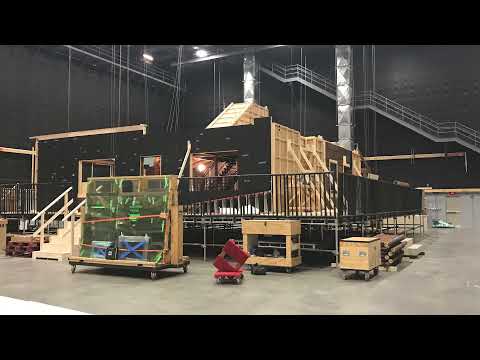Discover the Exciting World of Set Dressing: Job Description and Salary

Set Dresser Job Description Template
Set Dresser Job Description A set dresser is a crucial member of the film, television, and theater production team who is responsible for creating and maintaining the visual appearance of the sets. They work closely with the production designer, art director, and set decorator to ensure that the sets accurately depict the desired time period, location, and ambiance of the production. The main responsibilities of a set dresser include: 1. Set Preparation: Set dressers are responsible for preparing the sets before filming or live performances. This involves arranging furniture, props, and set pieces in a visually appealing and functional manner. They must pay attention to details such as proper placement, alignment, and organization of the set elements. 2. Set Maintenance: During the production, set dressers are responsible for maintaining the sets. They need to ensure that everything remains in place, props are in proper condition, and any necessary repairs or replacements are made promptly. They may also need to make adjustments to the set between scenes or acts. In addition to these primary responsibilities, set dressers may also be involved in sourcing and acquiring props and set pieces, collaborating with other departments such as costumes and lighting, and assisting with set changes and strike-downs. Overall, the role of a set dresser requires a keen eye for detail, strong organizational skills, creativity, and the ability to work efficiently within tight schedules. They play a crucial role in bringing the production’s visual concept to life and creating a realistic and immersive environment for the audience.Set Dresser Responsibilities
Set Dresser Requirements
- Ability to read and interpret set design plans and blueprints
- Physical strength and stamina to lift and carry heavy set pieces and props
- Knowledge of various construction materials and tools
- Experience in carpentry, painting, and other skilled trades
- Attention to detail and precision in set placement and decoration
- Ability to work efficiently and meet tight deadlines
- Good communication and collaboration skills to work with production team and other departments
- Flexibility to adapt to changes in set design or production needs
- Problem-solving skills to resolve any issues or obstacles during set dressing
- Knowledge of safety protocols and procedures to ensure a safe working environment
How Much Does A Set Dresser Make?
Set Dresser Salary
| Experience Level | Salary Range |
|---|---|
| Entry Level | $30,000 – $40,000 |
| Mid-Level | $40,000 – $60,000 |
| Senior Level | $60,000 – $80,000 |
A set dresser is responsible for arranging and decorating film and television sets to create the desired atmosphere and look. They work closely with the production designer and art director to ensure that the sets match the vision of the project. The salary of a set dresser varies depending on their experience level. Entry-level set dressers can expect to earn between $30,000 and $40,000 per year. Mid-level set dressers with more experience may earn between $40,000 and $60,000 per year. Senior-level set dressers, who have extensive experience and may also take on supervisory roles, can earn between $60,000 and $80,000 per year.
Set Dresser Salaries by Country
Top Paying Countries for Set Dresser
| Country | Average Salary (USD) |
|---|---|
| United States | $48,000 |
| Canada | $36,000 |
| Australia | $32,000 |
| United Kingdom | $30,000 |
| Germany | $28,000 |
Set dressers play a crucial role in the film and entertainment industry, responsible for creating and arranging the visual elements of a set. The salaries for set dressers can vary greatly depending on the country. According to recent data, the United States offers the highest average salary for set dressers at $48,000 per year. Canada follows with an average salary of $36,000, while Australia, the United Kingdom, and Germany offer average salaries of $32,000, $30,000, and $28,000 respectively. These figures highlight the differences in earning potential for set dressers across different countries.
A video on the topic Set Dresser
Video Source : PERSPECTIVInterview Questions for Set Dresser
1. What is the role of a Set Dresser?
A Set Dresser is responsible for arranging and decorating the set to create the desired atmosphere and enhance the storytelling of a film or television production.
2. What skills are required to be a successful Set Dresser?
Successful Set Dressers should have strong artistic and creative abilities, excellent attention to detail, good organizational skills, and the ability to work well under pressure and meet deadlines. They should also have knowledge of different design styles, materials, and construction techniques.
3. Can you describe the process of set dressing?
The process of set dressing involves collaborating with the production designer and art director to understand the vision and requirements for the set. Set Dressers then source, select, and acquire furniture, props, and other decorative elements. They arrange and position these items on the set, ensuring that they are aesthetically pleasing and contribute to the overall look and feel of the production.
4. How do you stay updated on current design trends and styles?
To stay updated on current design trends and styles, Set Dressers often research and follow design blogs, magazines, and social media accounts related to interior design, architecture, and set dressing. They may also attend industry events, workshops, and conferences to network with other professionals and learn about new techniques and materials.
5. How do you handle last-minute changes or requests on set?
Handling last-minute changes or requests on set is a common occurrence in the film and television industry. Set Dressers need to be flexible and adaptable, able to quickly problem-solve and make adjustments to accommodate the changes while still maintaining the desired aesthetic and storytelling goals.
6. Can you describe a challenging project you worked on and how you overcame the challenges?
One challenging project I worked on was a period drama set in the 1920s. The budget was limited, and finding authentic period furniture and props was a challenge. To overcome this, I researched local vintage stores, thrift shops, and online marketplaces to find affordable options that closely resembled the desired style. I also utilized my skills in distressing and aging techniques to make newer items appear older and more authentic.
7. How do you ensure the safety of the set and its occupants?
Ensuring the safety of the set and its occupants is a crucial responsibility for Set Dressers. They should be knowledgeable about fire safety regulations, electrical safety, and general set safety protocols. Set Dressers should also inspect furniture and props for any potential hazards and secure them properly to prevent accidents or injuries.
8. Can you discuss your experience working within a budget?
Working within a budget is an essential aspect of being a Set Dresser. I have experience in sourcing cost-effective options, negotiating prices, and repurposing existing items to fit the desired aesthetic. I also maintain detailed records of expenses to ensure that the budget is properly managed and accounted for throughout the project.
9. How do you collaborate with other members of the production team?
Collaboration is key in the film and television industry. As a Set Dresser, I work closely with the production designer, art director, set decorator, and other members of the art department. I actively participate in meetings, offer creative input, and ensure that the set dressing aligns with the overall vision of the production. Effective communication and teamwork are essential for a successful project.
10. Can you explain any specific techniques or tools you use in your set dressing work?
Set Dressers use a variety of techniques and tools to enhance the set’s appearance. This can include distressing and aging techniques to make items look worn or weathered, using color psychology to create a specific mood, and utilizing scale and proportion to ensure the set looks visually appealing on camera. Tools commonly used include paintbrushes, drills, hammers, and various hand tools for assembling or modifying furniture and props.






